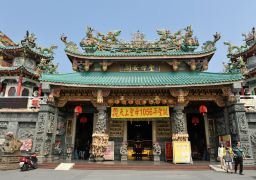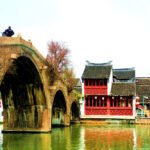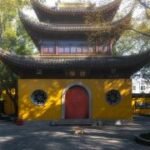Da Tianhou Palace, commonly known as the Tainan Mazu Temple, was built in the 23rd year of the Qing Kangxi era (AD 1684)
Originally the residence of the Ming Ningjing Prince, it was expanded into a grand Mazu temple by Lang, who attributed the success of pacifying Taiwan to Mazu

The temple has undergone several renovations and is listed as a historical site in the Taiwan region
Mazu, also known as Tianhou, is a deity worshipped by generations of sailors, travelers, merchants, and fishermen
The Mazu culture in Taiwan is particularly strong and is related to the coastal fishermen’s culture
Before setting sail, ships would first offer sacrifices to Tianhou to pray for favorable winds and safety, and a shrine to Tianhou would be set up on board
Da Tianhou Palace is the only Mazu temple among nearly 400 in Taiwan to be included in the official spring and autumn sacrificial ceremonies
The statues and sculptures in the temple are all created by famous craftsmen
The preciousness and richness of the ancient plaques and couplets are rare among temples in Taiwan
Da Tianhou Palace can be mainly divided into four parts: the San Chuan Hall, the Worship Hall, the Main Hall, and the Rear Hall, known as the ‘Four Progressions’
In front of the Main Hall, there is a Danchi stone wall carved with dragons flying and clouds, which is rare among other temples and fully displays the style of imperial architecture
At the main entrance, the first thing you see is a pair of stone lions in front of the door, with exquisite carving and unique shape
The entrance door is tall and majestic, without the traditional temple’s painted door gods, but equipped with many protruding wooden studs, and on both sides are eight horses and dragon-tiger patterns carved from granite, which are vigorous and rough
Looking from the main hall door to the inside, through the gradually rising courtyard and the narrow space of the houses, you can see the Mazu statue under the smoke and golden curtain from a distance
Mazu has a kind and peaceful demeanor
It is said that Mazu was originally pink-faced, but after a century of being surrounded by incense, the Mazu you see now has become a black ‘smoke face’
This statue was made by a Quanzhou master about 300 years ago and can be said to be one of the representatives of Taiwan’s clay sculptures
On both sides of the Mazu statue, there are shrines to the Dragon Kings of the East, West, South, and North, as well as the Water Fairy King
In addition, the temple also has a characteristic that, in addition to the main hall’s Mazu being called ‘Big Mother’, there are also so-called ‘Second Mother’ and ‘Third Mother’ Mazu statues, which are only half the size of the Big Mother, with pink faces and open eyes, different from the drooping eyelids of the Mazu statue
You might as well visit when you have time
The temple is open all year round from 06:00 to 21:00, and the specific business status is subject to the actual opening situation on the day






